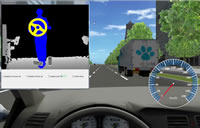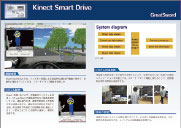Results for VDWC / CPWC
Final Evaluation and Awards Ceremony held as highlight of Design Festival
2014.
Entries to Virtual Design World Cup (VDWC), also known as The 4th Student
BIM&VR Design Contest on Cloud (Organized by Virtual Design World Cup
Executive Committee), were received from a total of 36 teams (15 from Japan
and 21 from outside Japan) and of those 36 teams, 15 have been nominated
through the first round review in July. Entries to Cloud Programming World
Cup (CPWC), also known as The 2nd Student Cloud Programming World Cup (Organized
by Cloud Programming World Cup Executive Committee), were received from
a total of 9 teams (4 from Japan and 5 from outside Japan) and all 9 teams
have been nominated through the first round in July. The Awards Ceremony
to present the winners of each competition was held on November 20, 2014,
Day 2 of the Design Festival.
| Title |
: |
The S.T.A.R.S. (Sustainable Taches and Reactivate Space) |
| Team Name |
: |
KUUPL |
| School Name |
: |
Kanazawa University |
 
| Title |
: |
Tokyo_Sustainable Development |
| Team Name |
: |
INED_UT |
| School Name |
: |
University of Transport and Communication |
 
Judge's Special Prize
■ Comments from Prof. Yasushi Ikeda, Chief of VDWC executive committee
The theme of VDWC this year was urban design in the area surrounding Shinkiba, Koto-ku for the Tokyo Olympic games in 2020. Because the theme itself aroused the interest of students worldwide, the total of number of entries to the competition was at a record high with applicants and award-winners from countries including Vietnam and the UK competing for the first time since we started the competition 3 years ago, making us feel this is becoming an international competition bearing a strong resemblance to the World Cup.
Probably many of the students as participants have never walked into this place. In fact, we deliberately chose this place as the target site of the competition for a particular aim. This idea of remoteness is indeed one of the characteristics of the competition that promotes the use of BIM. I do not mean we should deny the importance of conducting a detailed research on-site to get the information required. However if the network age offers the possibility of easily summarizing different viewpoints from different parts of the world, the VR technology and simulation technology that use BIM, both of which help people understand the spatial perspective on the target site without going there, should definitely be the ideal technologies which realize this possibility. Although many of the various ideas illustrated in different deliverables submitted in the end have some room for improvement, they also have potential for unexpected growth. Come to think of it, this competition itself might be the new form of collaboration in which wisdom in different fields can be combined and revitalized by sharing those ideas as 3D data.
All of the works by top teams were interesting. However I was faintly disappointed that I could hardly see the works that provided an answer (with a proposal that uses BIM) to the theme, which asked for an urban design in chronological order covering a long time span from day 1 of the 2020 Olympic games to the future beyond the days of the games. Cities change and grow, and through an effective use of design models computerized via BIM the process of the cities' metamorphosis can be foreseen and ways to adapt to those changes can be perceived. The essence of BIM is its ability to design not only the "Shape" with a theme of growth but also the "Mechanism" of growth as a concrete methodology. I have a high expectation that new design would be discovered together with the existing known method via BIM.


| Title |
: |
Kinect Smart Drive |
| Team Name |
: |
Great Sword |
| School Name |
: |
Shanghai Jiao Tong University |
 
Judge's special prize
■Comments from Prof. Tomohiro Fukuda, Chief of CPWC Executive Committee
The 2nd Student Cloud Programming World Cup (CPWC) was organized and held in quest of new possibilities of VR software. The objective is to give students the opportunity to improve their project planning capability, system development capability, and presentation skills through participation in the CPWC. In addition, we hope we can pursue new possibilities of contents through the development of actual applications.
The registration for the competition in its 2nd year opened in April 2014 and the first round presentation/review was held in Hawaii in July of the same year to evaluate 8 work plans submitted by 8 teams by the end of June. At that time, we passed all 8 teams and gave feedback on the specific areas that need improvement by the judging period in October to choose the nominated works. The final version of each of the 8 works was submitted by October 10th, and out of the eight works, 6 best works were nominated upon evaluation to be kept for the final round. The nominated teams assembled in Shinagawa, Tokyo, Japan in November 20th, to give their final presentation during the Awards Ceremony. The work "Kinect Smart Drive" developed by a team known as Great Sword (from Shanghai Jiao Tong University) that won the Grand Prix as a result of final evaluation is a system that links Kinect with UC-Win/Road. The system exhibited a high degree of perfection with a promise of further development in the future.
There was more diversity in the submissions compared to last year's competition.
Here we will introduce other award-winning works. The work by a team called
Chocolat (from Sugiyama Jogakuen University) who won the Environmental
Design and IT Award had a theme of roundabout. The work by SDL (Kyushu
University) is a test environment for a Driving Simulator to test automated
driving systems under various road and traffic conditions. The work by
Torneko (Shanghai Maritime University) who won the Cloud-sourcing Award
uses Open Street Map as a source of road network data. A system developed
by Kaisers (Kansai University) who won the Real World Application Award
applies vehicle control information logged by Driving Support Plugin developed
in the course of their project to the driving simulation under driving
and road conditions experienced in the real world.


|
